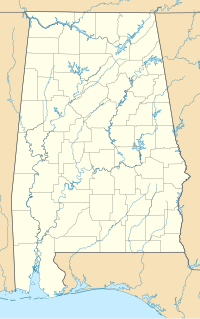Claiborne, Alabama
| Claiborne, Alabama | |
|---|---|

A street in Claiborne during the 1850s
|
|
| Location within the state of Alabama | |
| Coordinates: 31°32′25″N 87°30′56″W / 31.54016°N 87.51554°W | |
| Country | United States |
| State | Alabama |
| County | Monroe |
| Elevation | 180 ft (50 m) |
| Time zone | Central (CST) (UTC-6) |
| • Summer (DST) | CDT (UTC-5) |
| ZIP code | 36445 |
| Area code(s) | 251 |
Claiborne is a ghost town on a bluff above the Alabama River in Monroe County, Alabama.
Situated near the Federal Road, Claiborne began during the Mississippi Territory period with a ferry over the river. During the Creek War a large fort, named Fort Claiborne, was established at the site by General Ferdinand Claiborne. He used the fort as a base for the invasion of the Creek nation with the Regular Army of the United States, the Lower Tombigbee Militia, and friendly Choctaw. The community of Claiborne began in 1816, on the former fort site.
Following the war Claiborne became one of the largest and fastest growing communities in what would become Alabama. Early settlers included three future Alabama governors: John Gayle, John Murphy, and Arthur P. Bagby. William B. Travis, a hero of the Alamo, lived in Claiborne for many years before leaving for Texas in 1831. Other prominent politicians included James Dellet and Charles Tait. The community was surveyed in 1819 by General John Coffee, with lots being numbered and sold. It was incorporated as a town on December 20, 1820 by the Alabama Legislature.
The first paddle steamer, the Harriet, to reach this far up the Alabama River landed at Claiborne in 1821. At that time the population had reached 2000 people. It had grown to 2500 by the time that the Marquis de Lafayette visited in April 1825 during his famous tour of all 24 US states. He was entertained in the newly built masonic hall, a building which, along with the William B. Travis house, still exists but was later moved to the nearby community of Perdue Hill. The town continued to expand during the 1830s, with the population peaking at roughly 5000 people. Claiborne served as the first county seat of Monroe County until 1832, when it was moved to the centrally located Monroeville. By then the town boasted two large hotels, numerous stores and business establishments, a cotton warehouse, a boarding house, a jail, a school, several churches, and a few hundred residences. At this point outbreaks of yellow fever and cholera stemmed further growth of the town.
...
Wikipedia

